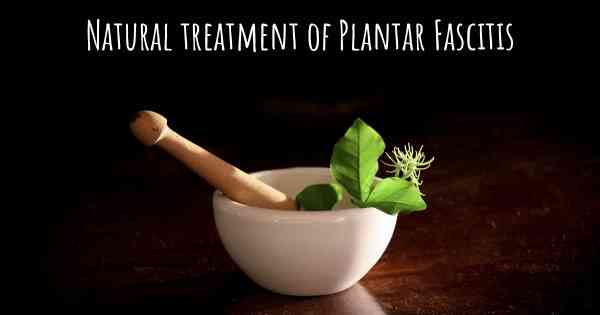Is there any natural treatment for Plantar Fascitis?
Are there natural treatment(s) that may improve the quality of life of people with Plantar Fascitis? Here you can see if there is any natural remedy and/or treatment that can help people with Plantar Fascitis

Natural Treatment for Plantar Fasciitis
Plantar fasciitis is a common condition that causes pain in the heel and bottom of the foot. It occurs when the plantar fascia, a thick band of tissue that connects the heel bone to the toes, becomes inflamed or irritated. While there are various treatment options available, including medications and physical therapy, many individuals prefer to explore natural remedies to alleviate their symptoms. Here are some natural treatments that may help relieve plantar fasciitis:
1. Rest and Ice
Rest is crucial for allowing the plantar fascia to heal. Avoid activities that worsen the pain, such as running or jumping. Instead, opt for low-impact exercises like swimming or cycling to maintain fitness without putting excessive strain on the foot. Additionally, applying ice to the affected area for 15-20 minutes several times a day can help reduce inflammation and relieve pain.
2. Stretching Exercises
Stretching exercises can help improve flexibility and reduce tension in the plantar fascia. Some effective stretches include:
- Calf stretches: Stand facing a wall with one foot in front of the other. Lean forward, keeping your back leg straight and your heel on the ground. Hold for 30 seconds and repeat several times on each leg.
- Towel stretches: Sit on the floor with your legs straight in front of you. Place a towel around the ball of your foot and gently pull it towards you, keeping your knee straight. Hold for 30 seconds and repeat several times on each foot.
- Toe stretches: Sit in a chair and place your affected foot over your opposite knee. Grab your toes and gently pull them back towards your ankle until you feel a stretch in the arch of your foot. Hold for 30 seconds and repeat several times.
3. Footwear Modifications
Wearing appropriate footwear can help alleviate symptoms and prevent further damage. Opt for shoes with good arch support and cushioning to reduce stress on the plantar fascia. Avoid high heels and shoes with inadequate support. Additionally, using orthotic inserts or shoe inserts specifically designed for plantar fasciitis can provide additional support and help distribute pressure more evenly.
4. Night Splints
Night splints are devices that hold the foot in a stretched position while you sleep. They help prevent the plantar fascia from tightening overnight, reducing morning pain and stiffness. Night splints can be purchased at most drugstores or obtained through a healthcare professional.
5. Massage and Self-Care
Massage can help relieve tension and promote healing in the plantar fascia. Roll a tennis ball or frozen water bottle under your foot for a few minutes each day. You can also use your hands to apply gentle pressure and massage the affected area. Additionally, practicing self-care techniques such as regular foot soaks in warm water, using Epsom salts, or applying essential oils may provide temporary relief.
6. Weight Management
Maintaining a healthy weight can significantly reduce the strain on your feet and lower the risk of developing or worsening plantar fasciitis. Excess weight puts additional pressure on the plantar fascia, making it more susceptible to inflammation and injury. Incorporating a balanced diet and regular exercise into your lifestyle can help manage weight and improve overall foot health.
7. Natural Supplements
While scientific evidence is limited, some individuals find relief from plantar fasciitis symptoms by taking certain natural supplements. These may include:
- Turmeric: Known for its anti-inflammatory properties, turmeric can be taken as a supplement or added to food.
- Ginger: Ginger has been used for centuries to reduce inflammation and relieve pain. It can be consumed as a supplement, in tea, or added to meals.
- Fish oil: Rich in omega-3 fatty acids, fish oil may help reduce inflammation. Consult with a healthcare professional before starting any new supplements.
It's important to note that while these natural treatments may provide relief for some individuals, they may not work for everyone. If your symptoms persist or worsen, it is advisable to consult with a healthcare professional for a proper diagnosis and personalized treatment plan.








